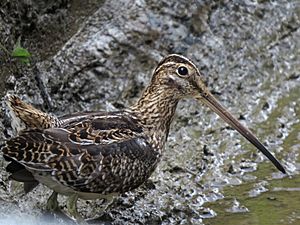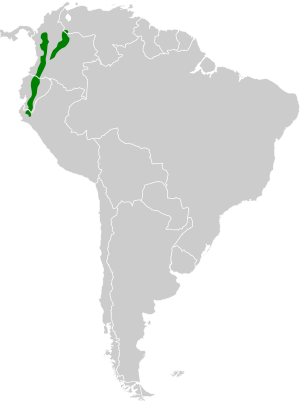Noble snipe facts for kids
Quick facts for kids Noble snipe |
|
|---|---|
 |
|
| Conservation status | |
| Scientific classification | |
| Genus: |
Gallinago
|
| Species: |
nobilis
|
 |
|
The noble snipe (Gallinago nobilis) is a small bird that lives near water. It's a type of wader, which means it often feeds in shallow water or mud. This bird makes its home in the Andes mountains, a long mountain range in South America. You can find it in countries like Colombia, Ecuador, Peru, and Venezuela. It lives high up in the mountains, either just below or above the tree line. Unlike many birds, the noble snipe does not migrate; it stays in the same area all year round.
Contents
What Does the Noble Snipe Look Like?
The noble snipe is about 30 to 32.5 centimeters (about 12 to 13 inches) long. It has a strong, sturdy body and legs that are quite short for a wader.
Its back, head, and neck are covered in stripes and patterns of dark brown and light brown (buff). Some feathers have golden edges, which create clear lines down its back. Its belly is white, but its sides have brown stripes.
The bird has a very long, straight bill that looks like a horn. Its legs and feet are a grayish-green color. Male and female noble snipes look very similar. However, female snipes usually have a longer bill. Young birds look much like the adults, but their wing feathers have pale edges. The noble snipe is known for its clear, pleasant song.
How to Tell it Apart from Other Snipes
Other types of snipes live in the same areas as the noble snipe.
- The Andean snipe has wider wings and a striped belly with dark feathers underneath.
- Migrating snipes like the common snipe and Magellan snipe are smaller. They also have more pointed wings and white edges on their wings.
Where Does the Noble Snipe Live and What Does It Do?
The noble snipe lives in high mountain areas. It prefers wet grasslands, marshes, and swamps. You can find it at elevations from about 2,700 to 4,200 meters (about 8,850 to 13,780 feet) above sea level.
Life and Habits
Scientists don't know a lot about the noble snipe's daily life. However, they do know it performs a special flight display in the air. During this display, the bird flies high in circles. Then, it dives down very fast. As it dives, its outer tail feathers vibrate, making a special "drumming" sound. This sound is deeper than the drumming sound made by the common snipe. The noble snipe usually breeds, or has its young, between March and July.
The noble snipe is often seen alone or in pairs. It can be hard to spot on the ground because its feathers help it blend in perfectly with the marsh plants. This is called cryptic plumage. It uses its long bill to search for insects and worms deep in the mud.
See also
 In Spanish: Caica de páramo para niños
In Spanish: Caica de páramo para niños



